Some of the big attractions at last month’s AUVSI North American conference were micro-UAVs. The Samurai UAV was especially impressive, sporting an unusual asymmetric design. You may have seen images of this amazing little device, but do yourself a favor and check out the video below of Engineering TV’s interview with Bill Borgia, Director of the Intelligent Robotics Laboratory at Lockheed Martin. Read more
Posts
 The Department of Defense is determined to field mobile devices that connect soldiers to networks for the rapid transmission of data. A number of forces have inspired this initiative:
The Department of Defense is determined to field mobile devices that connect soldiers to networks for the rapid transmission of data. A number of forces have inspired this initiative:
- Younger soldiers, by their own volition, are using their own smartphones and tablets whenever possible.
- The doctrine of network-centric warfare has upended the traditional paradigm of sending ISR to the rear echelons and is instead emphasizing delivering real-time info to the front lines.
- Enemy forces have successfully used cell phones to relay information in their own networks. Read more
 The Department of Defense’s (DoD) ambitious smartphone program may or may not reach its goal of providing advanced mobile communication devices to the warfighter, but it certainly has already scored one noteworthy achievement: creating stories for journalists. At last count, Google News has 300+ entries for “military smartphone.” Most of these stories report that the single biggest obstacle to smartphones deployment is security. Read more
The Department of Defense’s (DoD) ambitious smartphone program may or may not reach its goal of providing advanced mobile communication devices to the warfighter, but it certainly has already scored one noteworthy achievement: creating stories for journalists. At last count, Google News has 300+ entries for “military smartphone.” Most of these stories report that the single biggest obstacle to smartphones deployment is security. Read more
An IEEE Spectrum article features an Al Jazeera video (see below) about Libyan rebels making their own weapons. The rebels transform a child’s toy into a weaponized UGV, prompting IEEE to conclude that “Anyone can (on principle, at least) build a robot, and given the need or the motivation, anyone can put a gun on one…”
 Officer.com recently ran an introductory article about Public Safety using what in the Defense world are referred to as Tactical Unmanned Aerial Vehicles (TUAV). No runway needed describes various applications, which for the most part, are the civilian equivalent of Intelligence, Surveillance, and Reconnaissance (ISR).
Officer.com recently ran an introductory article about Public Safety using what in the Defense world are referred to as Tactical Unmanned Aerial Vehicles (TUAV). No runway needed describes various applications, which for the most part, are the civilian equivalent of Intelligence, Surveillance, and Reconnaissance (ISR).
Experts are repeatedly quoted that the technology not only exists for Public Safety applications, but also is extremely mature. The two main challenges are delivering solutions that are economical enough for cash-strapped civilian agencies, and, of course, FAA regulatory fears about mid-air collisions. Read more
Despite the ad with the drumming bunny, batteries in unmanned systems do not last forever. In fact the performing rabbit robot’s power lasts only three to four minutes.
Battlefield robots do better (a typical UGV batteries may last about 2 hours), but power is a huge challenge. This seems counter-intuitive, since one of the main advantages of unmanned systems is that, by definition, they don’t have to lug around people. However, mobility is only one source of power consumption. Communications and cooling systems may actually be more of a drain than simple transport. Read more
 Every once in a while, someone asks me to translate military jargon, or more often summarize a lengthy statement into an “executive summary.” Here are a couple of examples of my attempts to convert a dense forest of words into a simple “take home message.”
Every once in a while, someone asks me to translate military jargon, or more often summarize a lengthy statement into an “executive summary.” Here are a couple of examples of my attempts to convert a dense forest of words into a simple “take home message.”The direction for unmanned systems and all of the Defense  community is clear; we must do more with less and do it faster. We need to create the best possible systems for tomorrow’s needs as soon as possible. One niggling little problem: what does tomorrow look like?
community is clear; we must do more with less and do it faster. We need to create the best possible systems for tomorrow’s needs as soon as possible. One niggling little problem: what does tomorrow look like?
For example, do we develop unmanned systems with multiple assets or a single asset? Which payload configuration will be desirable for the future warfighter?
The obvious answer would seem to be, the more the better. Take the case of Sensitive Site Exploitation (SSE). Soldiers would love to have a robot that can enter a potentially dangerous house and clear it with non-lethal stun grenades. Of course, any armed application should be matched with optical surveillance capabilities as well. Olfactory sensors would be valuable in detecting explosives. When you add to the wish list an IED jammer and maybe the ability to detect ABC weapons, a multiple-asset unmanned system seems virtually certain. Read more
One of the big changes for military vendors in recent years has been the greater emphasis placed on acquisition of Commercial Off The Shelf (COTS) products by the Department of Defense (DoD). In the past, COTS constituted a few percent of all items purchased by the DoD. While the overall amount is still low, some weapon systems are composed by as much as 50% of COTS. What are the good, the bad and the ugly about COTS?
emphasis placed on acquisition of Commercial Off The Shelf (COTS) products by the Department of Defense (DoD). In the past, COTS constituted a few percent of all items purchased by the DoD. While the overall amount is still low, some weapon systems are composed by as much as 50% of COTS. What are the good, the bad and the ugly about COTS?
Good:
1) Cost: One of the main drivers for the acquisition of COTS has been the price. By definition, COTS products have no development cost, so, in theory, the DoD gets a cheaper item. Despite its behemoth budget, Defense still accounts for a minuscule part of the electronics market. So, by buying from the much larger commercial sector, DoD also benefits from economy of scale. Read more
At a gathering of unmanned systems professionals, I heard a lot of griping about product development. Trying to deliver a system that the government wants was impossible, because of the time lag. Who knows what the Department of Defense would want or need 2 or 5 years from now? All participants in the meeting agreed that it was the governments’ fault. The Feds simply weren’t telling us what they wanted. Well, it’s not for the lack of trying. It seems every week there’s a new roadmap, report, vision, or long-term plan. I recently reviewed my personal collection of downloaded documents and came up with: Read more
griping about product development. Trying to deliver a system that the government wants was impossible, because of the time lag. Who knows what the Department of Defense would want or need 2 or 5 years from now? All participants in the meeting agreed that it was the governments’ fault. The Feds simply weren’t telling us what they wanted. Well, it’s not for the lack of trying. It seems every week there’s a new roadmap, report, vision, or long-term plan. I recently reviewed my personal collection of downloaded documents and came up with: Read more
American Reliance, Inc.
789 N Fair Oaks Ave,
Pasadena, CA 91103
Office Hours
Monday-Friday:
8:00 am – 5:00 pm PST
Saturday: Closed
Sunday: Closed
Main: +1 (626) 482-1862
Fax: +1 (626) 226-5716
Email: AskUs@amrel.com
Blog Posts
Mobile Biometric Solutions
Mobile Biometric Smartphones & Tablets
BioFlex S® Commercial Smartphones
BioSense AT80B | 8″ Android Biometric Tablet
BioSense PA5 | 10.1″ (Gen 2) Android Biometric Tablet
BioSense PA5 | 10.1″ Android Biometric Tablet
BIOPTIX PM3B | 7″ Windows Biometric Tablet
BIOPTIX PM5B | 10.1″ Windows Biometric Atom Tablet





